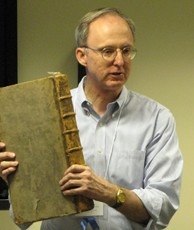G-20. Printed Books to 1800: Description & Analysis
David R. Whitesell
“Connecting the physicality of the pressroom to format and collation gave me a great model to think through the discovery process with a new book.” — 2017 student
Course Length: 30 hours
Course Week: 8–13 June 2025
Format: in person, University of Virginia in Charlottesville, VA
Fee: $1,495
The course is intended for collectors, booksellers, librarians, educators, and others who seek an introduction to the physical aspects of books printed during the hand-press period (1450–1800). Via lectures and hands-on workshops, the course covers the identification and description of paper (laid vs. wove, watermarks, sheet sizes); typography (type sizes, fonts, and non-textual material); letterpress composition and printing; illustration processes (relief, intaglio) and their use in hand-press books; binding materials (textile, leather, parchment, paper), methods, and decoration; provenance (markings, inscriptions, bookplates, the ways in which books have been physically altered by their owners); bibliographical description; and the use of physical evidence to address broader questions. Topics include: how to read a bibliographical description of a hand-press-period book (format, collation, signings, pagination); edition, issue, and state; and online resources concerning the physical aspects of pre-1800 books. The course relies heavily on Rare Book School’s rich collection of hand-press books and related artifacts.
In their personal statement, applicants should describe the extent of their background in the history of books and printing, the nature of their interest in the subject, and how they expect to apply what they learn. There is no formal prerequisite for the course, though students with no prior exposure to hand-press books may be directed to other Rare Book School course(s) before being offered admission to G-20.
Note on the differences between the “Printed Books: Description & Analysis” courses (G-20 and G-30) and Introduction to the Principles of Bibliographical Description (G-10)
Introduction to the Principles of Bibliographical Description (G-10) and the “Printed Books” courses (G-20 and G-30) cover similar ground. G-10, however, focuses intensively on format, collation, and the rigorous description of hand- and machine-press period books through description practice and lab sessions; it also emphasizes self-study of physical features and terminology through museum sessions. Its primary text is Fredson Bowers’ Principles of Bibliographical Description, supplemented by Philip Gaskell’s A New Introduction to Bibliography.
In the “Printed Books” courses, Gaskell serves as the principal text. G-20 and G-30 are intended for collectors, booksellers, librarians, educators, and others who seek an introduction to the physical features of printed books—presented in a more traditional, interactive seminar setting—but who do not wish to spend extended time on the study of format and collational formulas. Students in all three courses enjoy extended contact with Rare Book School’s renowned study collections of books, bindings, and related artifacts.
If you anticipate the need to prepare your own bibliographical descriptions, including accurate collational formulas, you may find G-10 more suited to your needs. If a broader overview, combined with the ability to interpret bibliographical descriptions, would better suit your professional or personal interests, then either of the “Printed Books” courses would be a good fit. Because of the overlap in course content, Rare Book School discourages students from applying to a “Printed Books” course and G-10 in the same year; however, students who complete either of the “Printed Books” courses are welcome to apply to G-10 in subsequent years, but not vice versa. Students who take G-10 will find themselves well prepared for the Advanced Descriptive Bibliography course (G-50).
Course History
Faculty

David R. Whitesell
David R. Whitesell retired as Curator in the Albert and Shirley Small Special Collections Library at the University of Virginia in 2022. He previously worked as Curator of Books at the American Antiquarian Society, Rare Book Cataloger at the Houghton Library, Harvard University, and in the antiquarian book trade. He has served as Secretary of the Bibliographical Society of America and as a Trustee of the American Printing History Association. His publications include First Supplement to James E. Walsh’s Catalogue of the Fifteenth-Century Printed Books in the Harvard University Library (2006); he also was Associate Editor for Spain, Portugal, and Latin America for the Oxford Companion to the Book (2010), and Editor of Roger Stoddard’s A Bibliographical Description of Books and Pamphlets of American Verse Printed from 1610 Through 1820 (2012; winner of the MLA Prize in Bibliography). Among the exhibitions he has curated are In Pursuit of a Vision: Two Centuries of Collecting at the American Antiquarian Society (2012) and A Curator’s Wunderkammer: A Decade of Collecting for the University of Virginia (2022).
